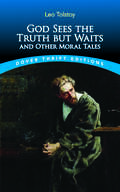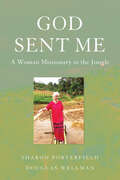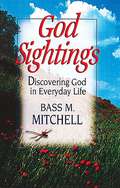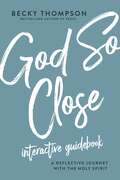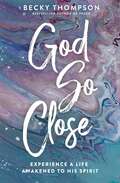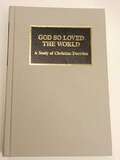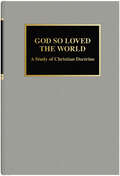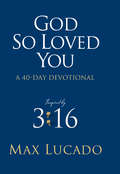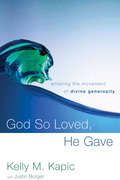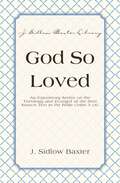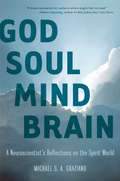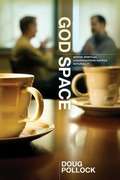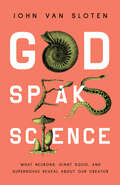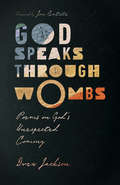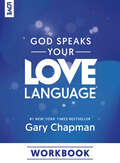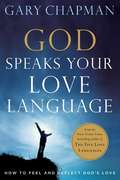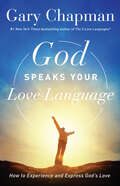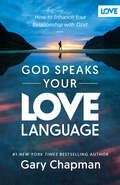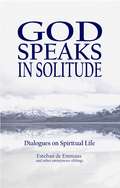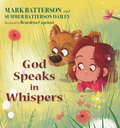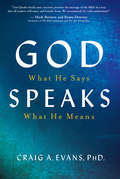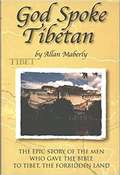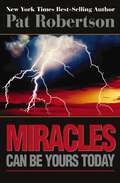- Table View
- List View
God Sees the Truth but Waits and Other Moral Tales (Dover Thrift Editions: Short Stories)
by Leo TolstoyAfter writing such popular novels as War and Peace and Anna Karenina, Leo Tolstoy experienced a religious crisis. By the late 1870s, Tolstoy had left the Russian Orthodox Church and embarked on a quest for spiritual truth, writing profound fable-like short stories. This volume features five enlightening tales that exemplify Tolstoy's spiritual journey, illuminating the paths to human virtue and salvation. Forgiveness blooms amidst injustice in "God Sees the Truth but Waits," while "What Men Live By" reveals the universal need for compassion. "Where Love Is, There God Is Also" is a nod to the Catholic hymn Ubi Caritas and exhibits the transformative power of divine love and charitable acts. "The Three Hermits" emphasizes the simplicity of faith and sincere prayer, and "Divine and Human" thunders the moral call to help those in need, defying personal risk and societal norms.
God Sent Me: A Woman Missionary in the Jungle
by Douglas Wellman Sharon PorterfieldRaised in wealth and privilege in Southern California, the last thing Sharon Porterfield ever expected was to become a Christian missionary in the hostile, unforgiving jungles of Southeast Asia. Her parents were atheists, but something inside her told her that there had to be a Creator. After years of searching and study, she became a committed Christian. In her mid-thirties she found a church she loved and ministered to at-risk women. She thought she had found her pect place in Christian service. She was wrong.One night a missionary spoke at her church. Disintered and half listening, she suddenly felt God pull her to invesigate. Seemingly against her will, she was strongly compelled to visit Burma and the Karen people who live there. She gave in and went. The country was hot, humid, and alive with scorpions and malaria infected mosquitoes, and the Burmese Army was always a threat, periodically launching genocidal attacks against the Karen. The most basic of creature comforts, like indoor toilets and easy access to food, were absent. Despite all this, Sharon fell in love with the Karen people and knew this was going to be her life's work, because God Sent her.
God Sightings: Discovering God in Everyday Life
by Bass M. MitchellWe cannot make the mountaintop experiences, those extraordinary encounters with God, the norm. We must not think that if we aren't having them all the time that something is wrong with our faith. Those mountaintop encounters are special gifts God gives us. We should cherish them. Revisit them. Draw strength from them. But we can't live there. God is as much, if not more so, in the valleys as on the mountaintops, if we will look and listen. From the Introduction Through thirty-one brief stories and reflections Bass M. Mitchell offers readers examples of how they might look and listen for "signs" of God each day of their life. Each selection begins with a verse of Scripture and ends with a prayer. Bass M. Mitchell is a freelance writer and pastor in Bath County, Virginia. He has served as a music director, a college instructor in religion, and a program director. Bass is a graduate of Duke University Divinity School.
God So Close Interactive Guidebook: A Reflective Journey with the Holy Spirit
by Becky ThompsonHow well do you know the Holy Spirit? How real is He in your everyday life? In this new interactive guide to accompany God So Close, bestselling author and creator of the Midnight Mom Devotional community Becky Thompson invites you into a closer relationship with the Holy Spirit. In God So Close, Thompson wants to lead you into a deeper understanding of the Holy Spirit so you can have a closer connection with God, scripturally unpacking who He is and how He moves in and through the life of believers. Now in The God So Close Interactive Guidebook, you&’ll discover:14 sessions that cover the entire God So Close bookAdditional scripture lessons and new storiesSpecific questions to help reflect on who the Holy Spirit is to youDesigned for use by those looking for a more personal journey through God So ClosePlease note: This product is a companion to God So Close, for the most optimal experience it should be completed while reading the original book (purchased separately).Long gone are the days of believing that the Spirit of God only attends certain church services or speaks to or through particular people. The God So Close Interactive Guidebook will help you process his power and presence. It&’s for His glory that you&’ve been given gifts to impact the world and reveal the message of Jesus.
God So Close: Experience a Life Awakened to His Spirit
by Becky ThompsonHow well do you know the Holy Spirit? How clearly do you hear His voice? How real is He in your everyday life?Bestselling author and creator of the Midnight Mom Devotional community Becky Thompson invites you into a closer relationship with the Holy Spirit by scripturally unpacking who he is and how he moves in and through the life of a believer.In God So Close, Thompson wants to lead you into a deeper understanding of the Holy Spirit so you can have a closer connection with God. Becky will help youexplore who the Holy Spirit is and why He is importantbecome aware of God moving around you and within youlearn how to listen for the prompting of the Holy Spiritdiscern when God is leading youLong gone are the days of believing that the Spirit of God only attends certain church services or speaks to or through particular people. God So Close shows you are a carrier of his Spirit and have been filled with his power and presence. It's for His glory that you've been given gifts to impact the world and reveal the message of Jesus.
God So Loved The World: A Study Of Christian Doctrine
by Lyle W. LangeDevoted entirely to Christian doctrine, this book emphasizes the gospel to show that Jesus and the salvation he won for all people are at the center of all Bible teachings. Readers are reminded that every biblical doctrine relates to Scripture's central teaching that God sent his Son to save lost sinners. Author Lyle Lange writes about the Bible's basic and more difficult teachings with special emphasis on Jesus so that readers, in turn, will be strengthened in their beliefs and be led to boldly share the gospel news with others. Seven sections--Introduction to the Study of Christian Doctrine, Theology, Anthropology, Christology, Soteriology, Eschatology, and Temporal Estates--cover topics such as the Trinity, angels, creation, Christ's threefold office, faith, conversion, justification, sanctification, election, the Antichrist, and marriage.
God So Loved The World: A Study of Christian Doctrine
by Lyle W Lange"These are the Scriptures that testify about me..." (John 5:39) Devoted entirely to what the Bible teaches and Christians believe, God So Loved the World emphasizes the gospel to show that Jesus Christ and the salvation he won for all people are at the center of all Bible teachings. You will be reminded that every biblical teaching relates to the Bible's central teaching that God sent his Son to seek and save lost sinners. Author Lyle Lange writes about the Bible's basic and more difficult teachings with special emphasis on Jesus so that you, in turn, will be strengthened in your beliefs and be led to boldly share the gospel news with other people. This masterful work of Christian doctrine is split into seven sections: In this book, you'll learn about topics such as the Trinity, angels, creation, Christ's threefold office, faith, conversion, justification, sanctification, election, marriage, and more! Introduction to the Study of Christian Doctrine Theology Anthropology Christology Soteriology Eschatology Temporal Estates
God So Loved You: A 40 Day Devotional
by Max LucadoGod So Loved You is a 40 day devotional inspired by Max Lucado and 3:16.
God So Loved, He Gave: Entering the Movement of Divine Generosity
by Justin L. Borger Kelly M. KapicThe God who created a good and perfect world, but whose world turned from him, has brought restoration through gift: The Father loved the world and gave the Son, and the Father and the Son pour out the gift of the Spirit into the hearts of humanity bringing about praise, hope, and new creation. Those who are united to the Son by his Spirit then find they have received the glorious gift of God’s coming Kingdom. In other words, the Gospel is shaped by giving: God’s generosity buys us out of bondage and brings us into all the blessings of belonging. But the good news is not only that God has made us to be recipients of his grace but also participants in the movement of his divine justice and generosity. Living in God’s gifts, Christians discover they are free to give themselves. The cross and resurrection of Christ come to shape and define this new life of faith, hope and generosity—a life that is best lived not in isolation but as a community. Throughout the book special attention is given to the relationship between divine generosity and concern for the poor and oppressed. Kapic and Borger encourage readers to not simply discover the immensity of God’s grace, but to enter into the flow of divine generosity as God has invited them to become avenues of his great gifts to the world.
God So Loved: An Expository Series on the Theology and Evangel of the Best Known Text in the Bible (John 3:16) (J. Sidlow Baxter Library)
by J. Sidlow BaxterThis expository treatment of the best known verse in the Bible, John 3:16, opens new vistas of meaning to Christian believers. Each message in this book points out and illustrates some pertinent aspect of the way of salvation.
God Soul Mind Brain
by Michael S. Graziano"Essential reading for the devout, the agnostic, and the atheist. In tackling the question of the religious brain, Graziano is respectful, sincere, and scientifically plausible. This might even be an Important Book."-Sam Wang, author of Welcome to Your Brain"A beautifully crafted, tightly scripted account of how the far-flung legions of the brain's neurons give rise to social awareness and our notions of soul, religion and God."-Christof Koch, author of The Quest for Consciousness"Lucid and engaging. . . . Moves with pace and humor."-Philip Johnson-Laird, author of Mental Models"Do we know the origins of Gods and ghosts? This well-written book makes the bold case that new discoveries in social neuroscience can illuminate human spiritual experience."-Terry Sejnowski, PhD, Salk Institute/UC San DiegoWriting for the general public, Michael S. A. Graziano explores the controversial relationship between science and religion, first dismissing the "science versus religion" debate as outdated. The cutting-edge field of social neuroscience explains how our perceptions of our own consciousness, of other minds, and of spirits and gods depend on machinery in the brain that evolved to make us socially intelligent animals. In clear prose without technical jargon, Graziano discusses his and others' findings in this twenty-year-old science and the implications for human spirituality and religion.Michael S. A. Graziano, professor of neuroscience, Princeton University, is the author of numerous articles on the functioning of the brain. He is internationally known for fundamental discoveries about sensory-motor coordination. His previous book on the brain, The Intelligent Movement Machine, was published by Oxford University Press in 2008.
God Space: Where Spiritual Conversations Happen Naturally
by Doug PollockYou've felt that tug... A friend, co-worker, family member, or someone you just met is talkingaand you sense God nudging you to say something. But what do you say? What donat you say? How can you bring God into the conversation without shutting it down? Welcome to God Space. Where the Holy Spirit can do amazing things through everyday conversations. Where honesty and transparency allow for discovery and deep connection. Where lives are challenged and changed. Connect with these real-life stories of how ordinary people learned how to engage others in rich spiritual conversations that open doors instead of slamming them shut. You'll find fresh insights and practical tools for connecting with others about the things that matter most.
God Speaks Again: an Introduction to the Baha'i Faith
by Kenneth E. BowersA modern and comprehensive introduction to this newest of the world's religions
God Speaks Science: What Neurons, Giant Squid, and Supernovae Reveal About Our Creator
by John Van SlotenA joy-filled expedition into experiencing God&’s majestic, everywhere presence.DNA, the Danube River, and deep-sea life. Knees and trees. The Swiss Alps, songbirds, and supernovas. God speaks though His creation. And you don&’t have to be naturally gifted at biology, chemistry, or physics to be awakened to His wisdom and majesty. Pastor, teacher, and non-scientist John Van Sloten invites us to know God more deeply as we marvel at the complexities of His amazing creation.Knowing God through His written Word enables us to know Him more clearly through His creational Words. How does God speak through His creation, and what is He saying? Each chapter includes interviews with leading scientists and connects creation to its Creator. With the primary foundation that Jesus is the mediator of both salvation and creation, Van Sloten fields questions such as:Why are things beautiful and how can beautiful things be engaged?How does the doctrine of the Trinity teach us about the nature of tree branches and wound healing?What do the doctrines of creation, incarnation, and the resurrection tell us about phenomenon of supernovas?How do we engage God&’s providence through knees and fossils?We were made to wonder. To marvel. To know and live in awe of God. God Speaks Science expands our hearts and minds so that we might delight in the wisdom, beauty, and awesome power of our triune God!
God Speaks Through Wombs: Poems on God's Unexpected Coming
by Drew JacksonBut God speaks through wombs, birthing prophetic utterances. . . . Enough of this unbelieving religion that masquerades as faith. Divine favor is placed on what we have disgraced. In God Speaks Through Wombs, Drew Jackson explores the first eight chapters of Luke's Gospel in a new poetic register. These are declarative poems, faithfully proclaiming the gospel story in all its liberative power. Here the gospel is the "fresh words / that speak of / things impossible." From the Magnificat ("That girl can sing! . . . She has a voice / That can shatter shackles") to the baptism of Christ ("I stepped in / Committing insurrection"), this collection helps us hear the hum of deliverance���against all hope���that's been in the gospel all along.
God Speaks Your Love Language Workbook
by Gary ChapmanThe essential companion book for God Speaks Your Love LanguageDo you want to feel God&’s love more personally?These ten lessons—created to strengthen and deepen your relationship with God and others—provide workable strategies for applying the principles of God Speaks Your Love Language. This workbook includes interactive questions, quizzes, charts, and diagrams—all aimed at helping you better experience love, express love, and identify areas for development. Whether you&’re working with this book as an individual, a couple, or in a small group, let patience, grace, and humor be your companions.As you begin to identify the variety of languages God uses to communicate love to you and others, you can learn to lovingly respond to God and to those around you. No matter what love language you prefer, you will become more deeply connected with God. And you will see this bond transform all your relationships.This interactive workbook helps you take the joy-filled insights of God Speaks Your Love Language and put them into practice!
God Speaks Your Love Language: How To Feel And Reflect God's Love
by Gary ChapmanPreviously published as The Love Languages of God, Gary Chapman explains how you can give and receive God's love through the five love languages: words of affirmation, quality time, gifts, acts of service, and physical touch.
God Speaks Your Love Language: How to Experience and Express God's Love
by Gary ChapmanMore than 200,000 copies soldFeel God&’s love more personally.Do you realize that the God of the universe speaks your love language, and your expressions of love for Him are shaped by your love language? Learn how you can give and receive God&’s love through the five love languages: words of affirmation, quality time, gifts, acts of service, and physical touch.Gary Chapman writes, &“As we respond to the love of God and begin to identify the variety of languages He uses to speak to us, we soon learn to speak those languages ourselves. Whatever love language you prefer, may you find ever deeper satisfaction in using that language in your relationship with God and with other people.&” The book includes a brand new chapter on &“Getting Out of Your Comfort Zone&” which will teach you the joys of speaking a love language you&’re not used to with God. No matter what love language you prefer, you will become more deeply connected with God and watch this bond transform all of your relationships. Contains personal reflection questions and a study guide for groups
God Speaks Your Love Language: How to Experience and Express God's Love
by Gary ChapmanMore than 200,000 copies soldFeel God&’s love more personally.Do you realize that the God of the universe speaks your love language, and your expressions of love for Him are shaped by your love language? Learn how you can give and receive God&’s love through the five love languages: words of affirmation, quality time, gifts, acts of service, and physical touch.Gary Chapman writes, &“As we respond to the love of God and begin to identify the variety of languages He uses to speak to us, we soon learn to speak those languages ourselves. Whatever love language you prefer, may you find ever deeper satisfaction in using that language in your relationship with God and with other people.&” The book includes a brand new chapter on &“Getting Out of Your Comfort Zone&” which will teach you the joys of speaking a love language you&’re not used to with God. No matter what love language you prefer, you will become more deeply connected with God and watch this bond transform all of your relationships. Contains personal reflection questions and a study guide for groups
God Speaks Your Love Language: How to Experience and Express God's Love
by Gary ChapmanMore than 200,000 copies soldFeel God&’s love more personally.Do you realize that the God of the universe speaks your love language, and your expressions of love for Him are shaped by your love language? Learn how you can give and receive God&’s love through the five love languages: words of affirmation, quality time, gifts, acts of service, and physical touch.Gary Chapman writes, &“As we respond to the love of God and begin to identify the variety of languages He uses to speak to us, we soon learn to speak those languages ourselves. Whatever love language you prefer, may you find ever deeper satisfaction in using that language in your relationship with God and with other people.&”The book includes a brand new chapter on &“Getting Out of Your Comfort Zone&” which will teach you the joys of speaking a love language you&’re not used to with God. No matter what love language you prefer, you will become more deeply connected with God and watch this bond transform all of your relationships.Contains questions for reflection and discussion
God Speaks in Solitude: Dialogues on the spiritual life
by Esteban de Emmaus and other anonymous siblingsDialogue is a pedagogic form much used in the early times of Christianity. By means of questions and answers, the disciple went on entering into the spiritual teacher's wisdom. Picking up this form so loved of the early desert Fathers, Brother Mario de Cristo Salvador presents us the spiritual journey of a young novice, in which each of us who ask questions and clarify doubts with a spiritual teacher with the desire of beginning, entering and ascending in the contemplative path, are represented,. Their conversations deal with a variety topics that assault those who begin on the spiritual path: how to begin to pray, how to overcome distractions, what is the role of asceticism in spiritual life, what to do with doubts on one’s own vocation and about faith, etc. an entire varied group of explanations that give peace to the beginner and encourage one who has already passed the first dwellings of the interior castle, in the expression of St. Teresa. This book can be a very effective help and an incentive for all those who don't dare to begin the path to prayer or, once begun, they doubt if to continue on it, before the difficulties that present themselves.
God Speaks in Whispers
by Mark Batterson Summer Batterson DaileyChildren often begin their faith journey with basic but big questions like How does God speak to me? This charming picture book from the best-selling author of Whisper and his daughter provides a fun and clever answer!God Speaks in Whispers helps even the youngest readers look for God's voice in the universe: in creation, as he speaks through his followers, and in the Bible as he speaks through his Word. With a charming rhyme pattern and vivid pictures, Mark and Summer Batterson invite little ones to imagine how God might be showing them love every day, by leaning in close to hear God's whisper.
God Speaks: What He Says, What He Means
by Dr Craig EvansDr. Craig Evans opens the door to the inquiring mind as to why 1) God chose to create the Bible, 2) those vital things we so often miss when we do read Scripture, and 3) why it really matters that we pay attention to the Word of God at all.
God Spoke Tibetan
by Allan MaberlyGod Spoke Tibetan: The Epic Story of the Men who Gave the Bible to Tibet, the Forbidden Land
God Still Does Miracles
by Pat RobertsonPat Robertson has seen, heard of, and been touched by thousands of miracles in his life and others'--many of which he shares in this book, but all of which provide a remarkable testimony of God's love for us. Robertson will also explore the miracles of Jesus, show the difference between positive thinking and true faith, and discuss the proven principles of miracles so that we too may live a miraculous life touched by God.
